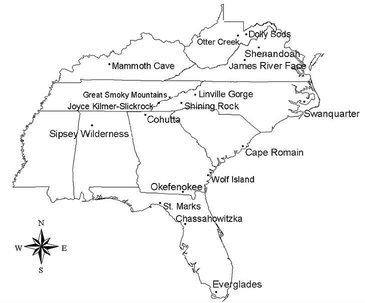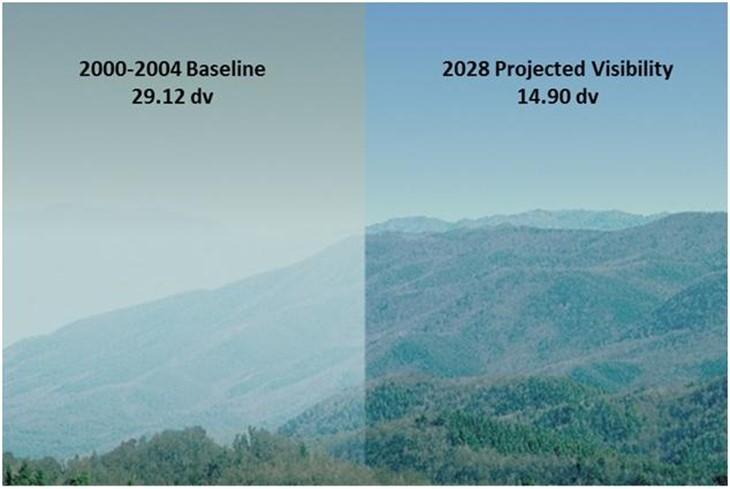Reduce Regional Haze
-
State Implementation Plan for Regional Haze - First Planning Period (Narrative)
- Regional Haze Periodic Progress Report - First Planning Period
- State Implementation Plan for Regional Haze - Second Planning Period
- Regional Haze Progress Report- Second Planning Period
Section 169A of the Clean Air Act provides for a visibility protection program to protect scenic vistas in 156 of the country’s federally managed wild areas, including national parks, wilderness areas, and wildlife refuges. Visibility in these wild areas (called mandatory Class I federal areas) is impaired by fine particulate matter generated from man-made sources. The fine particles scatter and absorb light that would otherwise reach the eye of an observer, thereby reducing visibility.
US EPA calls the impairment of visibility “regional haze”, which is defined in 40CFR51.300 as “… visibility impairment that is caused by the emission of air pollutants from numerous sources located over a wide geographic area.” Visibility impairment is defined as “… any humanly perceptible change in visibility (light extinction, visual range, contrast, coloration) from that which would have existed under natural conditions.”
The goal of the visibility protection program is to restore the visibility in each of the Class I areas to its natural value by reducing man-made emissions of pollutants. EPA’s regional haze rules (40CFR51.300 - 40CFR51.309) establish a framework for achievement of natural visibility by 2064, starting from a baseline period of 2000 – 2004. For the purposes of the regional haze rules, visibility impairment is based on ambient measurements at selected monitors and is expressed in units of deciviews (dv). Lower impairment corresponds to better visibility. Read more information on EPA’s regional haze rules.
In Georgia there are three mandatory Class I areas:
- Cohutta Wilderness Area (northwest GA),
- Okefenokee National Wildlife Refuge (south central GA), and
- Wolf Island National Wildlife Refuge (coastal GA).
There are numerous Class I areas in other southeastern states. Locations of the Class I areas in Georgia and in nearby states are shown on the map below.
Mandatory Class I Federal Areas in Southeastern States

Reasonable Progress
The regional haze rule requires Georgia to establish state plans that contain “reasonable progress goals” (RPGs) for improvement of visibility in each of the State’s Class I areas. These plans are required to be done every ten-years until 2064. In addition to establishing reasonable progress goals, states must include a monitoring strategy for measuring, characterizing, and reporting regional haze visibility impairment in their State Implementation Plan (SIP). Georgia is required to establish and implement a long-term strategy that will achieve the reasonable progress goals for Georgia’s Class I areas and support the achievement of the goals for selected out-of-state Class I areas. The long-term strategy includes enforceable emissions limitations, compliance schedules, and other measures as necessary to achieve the reasonable progress goals. States must also consider ongoing control programs, measures to mitigate construction activities, source retirement and replacement schedules, smoke management techniques for agriculture and forestry, and enforceability of specific measures. In developing this SIP, the Georgia Environmental Protection Division (GA EPD) considered emission sources outside of Georgia that may affect visibility at Georgia Class I areas, and emission sources within Georgia that may affect visibility at Class I areas in neighboring states.
The tables below display Georgia’s 2028 reasonable progress goals for the 20 percent most impaired days and the 20 percent clearest days.
| Class I Area | 2000-2004 Baseline Visibility (dv) | 2028 Reasonable Progress Goals (dv) | Natural Visibility (dv) |
|---|---|---|---|
| Cohutta Wilderness Area | 29.12 | 14.90 | 9.88 |
| Okefenokee National Wilderness Area | 25.34 | 16.90 | 9.45 |
| Wolf Island National Wilderness Area | 25.34 | 16.90 | 9.45 |
| Class I Area | 2000-2004 Baseline Visibility (dv) | 2028 Reasonable Progress Goal (dv) |
|---|---|---|
| Cohutta Wilderness Area | 13.73 | 9.15 |
| Okefenokee National Wilderness Area | 15.23 | 11.58 |
| Wolf Island National Wilderness Area | 15.23 | 11.58 |
GA EPD compared baseline visibility conditions to natural visibility conditions in each Class I area and determined the uniform rate of progress (URP) in deciviews that would need to be maintained during each implementation period to attain natural visibility conditions by 2064. GA EPD summarized expected visibility improvements under existing Federal and State regulations, and any additional control measures found to be reasonable to implement in this review period. The impact of these controls was modeled using the Community Multiscale Air Quality (CMAQ) model. The modeling results were used to set reasonable progress goals.
GA EPD has determined that the 2028 RPGs will be significantly below the URP glide path for the 20% most impaired days at Cohutta Wilderness Area, Okefenokee National Wilderness Area, and Wolf Island National Wilderness Area. Also, the 2028 RPGs will be significantly below the 2000-2004 baseline visibility conditions for the 20% clearest days at Cohutta Wilderness Area, Okefenokee National Wilderness Area, and Wolf Island National Wilderness Area.
Setting Reasonable Progress Goals (RPGs)
In order to achieve clearer ambient conditions and establish the State’s RPGs, GA EPD screened for and selected facilities that had emissions which caused a significant impact on Class I areas. These selected facilities were evaluated based on four factors to determine if it was “reasonable” to reduce their emissions. The four factors being:
- Costs of compliance
- Time necessary for compliance
- Energy and non-air quality environmental impacts of compliance, and
- Remaining useful life of any potentially affected sources.
The State then coordinated with fellow States, EPA, Federal Land Managers, and the Public to review the RGPs and to incorporate them into the Regional Haze SIP.
The next progress report will be due to EPA by January 31, 2025. If emissions controls are not on track to ensure reasonable progress, then States would need to take action to ensure emissions controls installed and operational by 2028 will be consistent with the SIP, or to revise the SIP to be consistent with the revised emissions forecast. The Regional Haze SIP for the third planning period is due to EPA by July 31, 2028. After that, the process will begin again for the next round of Regional Haze.
